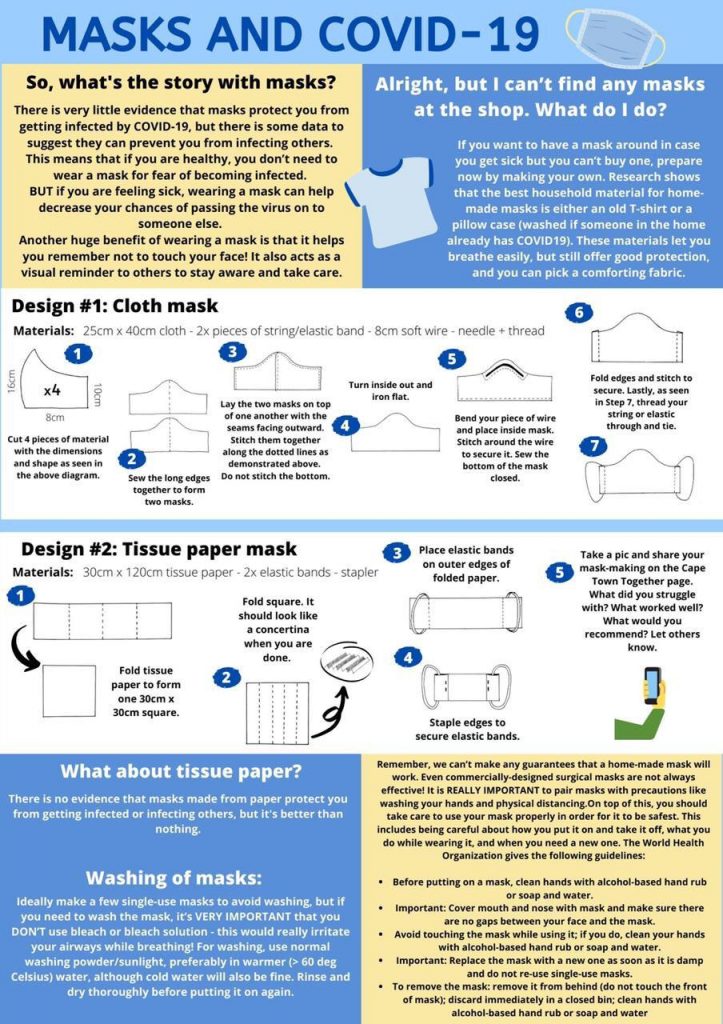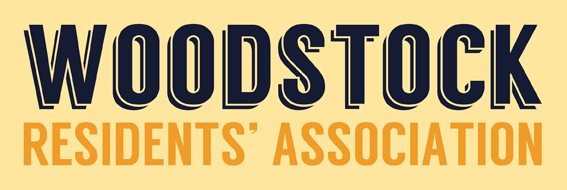So, what’s the story with masks?
There is very little evidence that masks protect you from getting infected by COVID-19, but there is some data to suggest they can prevent you from infecting others.
This means that if you are healthy, you don’t need to wear a mask for fear of becoming infected.
BUT if you are feeling sick, wearing a mask can help decrease your chances of passing the virus on to someone else.
Another huge benefit of wearing a mask is that it helps you remember not to touch your face! It also acts as a visual reminder to others to stay aware and take care.
Alright, but I can’t find any masks at the shop. What do I do?
If you want to have a mask around in case you get sick but you can’t buy one, prepare now by making your own. Research shows that the best household material for home-made masks is either an old T-shirt or a pillow case (washed if someone in the home already has COVID19). These materials let you breathe easily, but still offer good protection, and you can pick a comforting fabric. Check out details for why scientists recommend these materials at: https://smartairfilters.com/en/blog/best-materials-make-diy-face-mask-virus/
For your pattern, there are a few different options:
DISCLAIMER: The patterns and instructions for making masks are the best we could find, but some of the information about how much masks protect you in the links below is incorrect. Also, the way some of the text is written could come across negatively. But we wanted to get the info out as soon as possible so please take notice of only the actual instructions for making masks and not the rest of the fluff.
- Option One: we recommend one of the masks from these links as the safest home-made types: https://www.instructables.com/id/DIY-Cloth-Face-Mask/ AND https://so-sew-easy.com/super-simple-face-mask/
- Option Two: For people who don’t have a sewing machine, this mask seems a little complicated to put together, but doesn’t need needle and thread: https://wwwnc.cdc.gov/eid/article/12/6/05-1468-f1
- Option Three: This mask is probably the simplest to make, but we think the least likely to be effective. Only use this one as a reminder not to touch your face: https://sewguide.com/make-a-fabric-mask/
What about tissue paper
There is no evidence that masks made from paper protect you from getting infected or infecting others, but it’s better than nothing. See this link for a great video:
Don’t have a mask? No problem! Here’s a simple and effective solution you can make for YOUR community. Remember if you are sneezing and coughing then wear a mask to protect others. Each one teach one! 😷Physical Distancing 💪🏽Social Solidarity. 👉🏽 Thanks to the organisers at Ndifuna Ukwazi for the video!
Posted by Jared Rossouw on Thursday, 19 March 2020
Remember, we can’t make any guarantees that a home-made mask will work. Even commercially-designed surgical masks are not always effective! It is REALLY IMPORTANT to pair masks with precautions like washing your hands and physical distancing.
On top of this, you should take care to use your mask properly in order for it to be safest. This includes being careful about how you put it on and take it off, what you do while wearing it, and when you need a new one. The World Health Organization gives the following guidelines:
- Before putting on a mask, clean hands with alcohol-based hand rub or soap and water.
- Important: Cover mouth and nose with mask and make sure there are no gaps between your face and the mask.
- Avoid touching the mask while using it; if you do, clean your hands with alcohol-based hand rub or soap and water.
- Important: Replace the mask with a new one as soon as it is damp and do not re-use single-use masks.
- To remove the mask: remove it from behind (do not touch the front of mask); discard immediately in a closed bin; clean hands with alcohol-based hand rub or soap and water
Washing of masks
Ideally make a few single-use masks to avoid washing, but if you need to wash the mask, it’s VERY IMPORTANT that you DON’T use bleach or bleach solution – this would really irritate your airways while breathing!
For washing, use normal washing powder/sunlight, preferably in warmer (> 60 deg Celsius) water, although cold water will also be fine. Rinse and dry thoroughly before putting it on again.
How do I let the world know if this is my first successful DIY project?
Take a pic and share your experience mask-making on the Cape Town Together page! What did you struggle with? What worked well? What would you recommend? Let others know.

